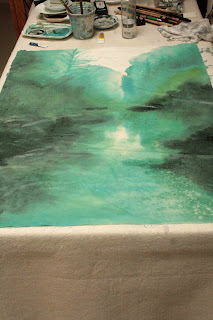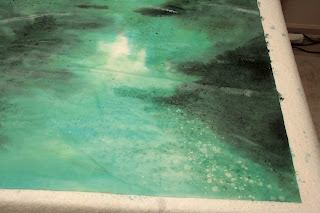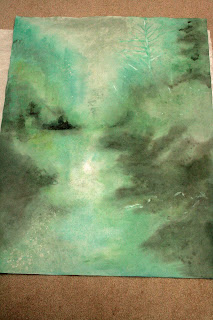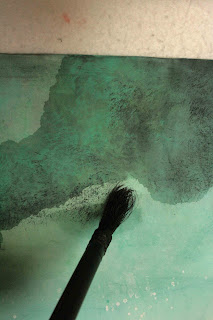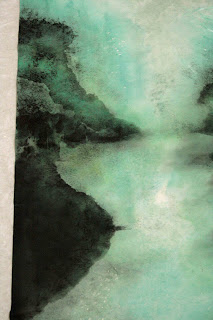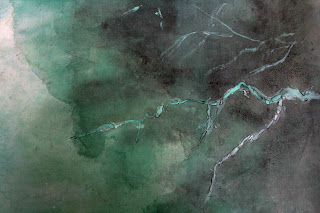This pond would have a dwarf weeping cherry tree and the Heron would come and stand next to it. Perhaps the bull frog season has ended, the Heron did not find much to stuff through its long neck. The creature just turned away from the water and chose to face the Dwarf; motionless, whilst the wind whipped up its chest feathers, betraying its presence.
I gave the title "ODD COUPLE" to this painting.
The painting was done in a cold tone. I tried to do the neck as a single brush stroke but I failed. It took several passes to get the shape down. I was hoping to write the neck as a reverse "S". The feathers were side tipped brush strokes. I used a rather dry brush to begin with, intended on bringing out the texture of the feathers but the resulting bird was too harsh. A moistened brush dabbing over the original strokes took care of that. The outline of the bird was done broken style. A continuous smooth line would resemble too much of the Gonbi style and would render this "motionless" heron "dead".
The dwarf weeping cherry on the other hand, was made to look menacing. The clawing branches and the exposed arthritic roots seem to mock the heron. There is a tension between the 2 subjects. The tension is not of an overt hostility, but a muted resolve of c'est la vie, que sera sera, whatever !! The heron has sought solace from an unlikely source. The tree can't just get up and walk away. It is what it is. How often do we find ourselves in this predicament, an uneasy acceptance of our fate?
I was a participant at a bazaar for arts and crafts, hawking my paintings at a ridiculously low price ( so I was told ). It was a juried event and I applied as an artist doing Chinese Brush Painting. This venue labeled me as a Sumi-e artist on the program. Granted my works do use ink and wash, but I am not a sumi-e artist, especially when I did not label myself as such. What is the big deal, you might ask. Let me put it in this perspective: A Chinese is an Asian, but not all Asians are Chinese. What's scary about this ordeal is that the event was sponsored by an art school as a fund raiser. Imagine how that school would teach Asian art?
So how did the art form that originated from China ended up being labelled here as sumi-e? When I was looking for teachers for my Chinese Brush Painting, I came across our local cultural center, whose putative mission was to bridge the cultures, and it offered classes in Spontaneous Chinese Brush and Elaborate Chinese Brush. Obviously I was confused. Fortunately I could read Chinese. What the center meant to advertise was that it offered classes in Xieyi and Gonbi styles of Chinese Brush. I objected vehemently to this advertising and was told that the non Chinese would not understand Xieyi or Gonbi. So how do we bridge the east and the west? How do we bridge any culture if we can't even be honest with ourselves, by calling a spade a spade, instead of saying an implement shaped like a flat scoop with a long handle used for digging. My suggestion was to stay with the proper nomenclature Gonbi and Xieyi, and put( Elaborate Chinese Brush ) and (Spontaneous Chinese Brush ) in brackets. Exposure is everything; we must allow people the opportunity to be familiar with and start using the proper terminology.
Do we translate proper nouns? Would anyone attempt to translate President Bush other than phonetically? Likewise we would not allow Chairman Mao to be translated as Chairman Hair! (Mao means hair in Chinese)
When China changed the nomenclature of Peking to Beijing, she asserted to the world that she wants the world to address her as she would address herself. Peking was probably the result of some foreigner trying to emulate Chinese pronunciation of Beijing. At first I was led to believe that this was pidgin English but later I understood pidgin English was something else totally. Yet during the last Olympics many of the news anchors from the U.S. ( some of them well known national personalities ) while doing the broadcast in situ , would insist on pronouncing the simple "J" sound in Beijing as a "J" sound in French "bon jour". These anchors must have known in their daily contact with the locals and yet they insisted on their assumption. The word Beijing meant "North" "Capitol". I am glad that it was not translated literally and only phonetically. When we insisted on calling Chow Mein by its proper name, people learned to accept it for what it is, just as they accepted crepe and baklava. Unfortunately us overseas Chinese, especially those of us in the States did not have the spine to insist on calling our fried rice as Chow Farn, thus allowing us to be the butt of the joke for saying "fly lice". I, for one, refuse to believe that Chinese could not distinguish "B" and "P" sounds, or that we are deaf to "R" and "L" sounds. My belief is that we are afraid to "stir up" trouble. We don't want to make a mountain out of a mole hill. We were taught to not offend others. After all people do get the gist of it, so why insist?
At the bazaar I overheard some Asians telling their western friends to ignore my booth because my "stuff" was "not Chinese" and they were really "not good". Obviously mine were not museum nor gallery pieces, but neither were any of the other artisans. Perhaps my pieces did not fit the stereotype? Did tramping on a fellow Asian elevate us to be more sophisticated and savvy or did it expose our own insecurity? Would I have felt the same betrayal had the people saying that were not Asians? For the price I was asking for, my works were real bargains, but that really wasn't the issue.
For my town of half a million souls, the population is innocently naive when it comes to Chinese Brush painting, or at least most of the fellow artists that I had dealt with are. Words like sumi-e and kanji are used generically sans ill will, just as Google had enjoyed the transformation from a noun to a verb. People are eager to show that they know something of the eastern culture but stumbled in their quest because they were never told the truth.
So there is this feeling of injustice, insecurity and ambiguity in me. Should I continue to voice what I perceive as inaccurate or just tolerate with a patronizing smile. Should I allow myself to be casted as a sumi-e artist doing spontaneous painting on rice paper? Need I worry that if I insist too strongly then there might not be a role for me to play at all, because the public would have perceived me of having a "bad attitude"; to coin a favorite corporate Management verbiage. The fact that local Chinese restaurants that serve Chinese food have few Caucasian clients and the Chop Suey joints here have no Chinese customers speak volume for my concern. Perhaps what I am serving up on my Xuan-boo is chop suey??
I blame this outburst on the holidays. I am told that people are a little moody around this time of the year. . I should know, I am a pharmacist. I must be the Grinch of the X'mas. Could it be I am just suffering from SAD? Better up my Prozac dosage, and in the meantime I'll protest in silence.
Let it be, just let it be, uttering under my breath.
HAPPY NEW YEAR




















